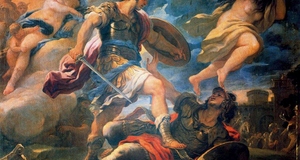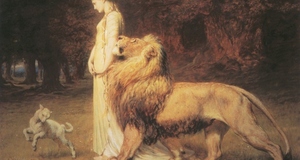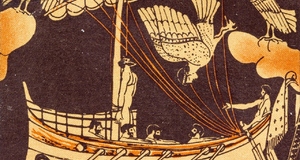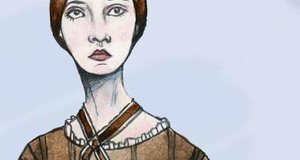|
From Discussions VOL. 5 NO. 2 Four Lines to Immortality: Dido's Renaissance Through Josquin des Prez
Dulces exuuiae, dum fata deusque sinebat,
accipite hanc animam meque his exsoluite curis.
uixi et quem dederat cursum Fortuna peregi,
et nunc magna mei sub terras ibit imago.
Dear pledges of my love, while Heav'n so pleas'd,
Receive a soul, of mortal anguish eas'd:
My fatal course is finish'd; and I go,
A glorious name, among the ghosts below.
(Virgil, Aeneid, 4:651-654, trans. John Dryden.)1
With these haunting final words, the young queen of Virgil's Aeneid, Dido, takes her life on a flaming pyre of her lover's belongings. The death of Dido is one of the most poignant moments in classical literature. Dido begins as an independent queen who rules Carthage without the aid of a male monarch, a model of chastity devoted to her late king. When the hero of The Aeneid, Aeneas, arrives in Carthage, Dido is forced by the gods to fall passionately in love with him. In the course of one book, the great queen becomes a suicidal woman broken by love , and a plaything of bickering gods. After proudly resigning herself to this grisly fate, the queen goes on to curse the day Aeneas' ships touched her shores: "From yonder sea may his cold Trojan eyes discern the flames that make me ashes! Be this cruel death his omen as he sails!" (Virgil, Aeneid, 4:661-662, trans. Theodore C. Williams). Yet, despite Dido's arresting invective towards Aeneas, the most powerful moment of her speech is not her attack, but her submission to fate.
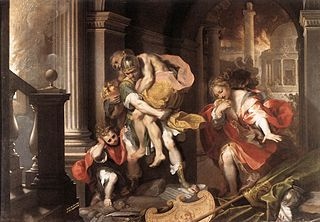
Many musical works recount Dido's last words; "Dido's Lament" by Purcell comes immediately to mind, as well as motet2 settings by Alexander Agricola, Jean Mouton, Mabriano de Orto, and Orlando de Lassus, among others.3 Josquin des Prez's setting of the queen's final speech became the model for a century of imitators. Instead of traversing into the territory of the weeping, livid woman later in the passage, the composer chose to immortalize her quiet acquiescence, setting only the four lines given above. A depiction of the Dido from a few lines later in the text shows her cursing Aeneas' arrival in Carthage and wishing for her death to become a bad omen for his ships. These cruel words are rife with dramatic tension and musical potential. Josquin's selection of the text, which begins with Dulces Exuviae is a powerful indication that he interpreted the maligned queen as a symbol of strength in the face of death. Josquin's interpretation of the text became a powerful model for later composers, and his choice of text allowed Dido to go "to the ghosts below" not as a madwoman queen, but as a glorious name amidst the timeless characters of classical literature (Dryden).
Despite the fact that Dido was best known in the Renaissance as a character, she was not an entirely fictional creation. There are many sources elaborating on the true queen. The real Dido was a Tyrian princess at the end of the 8th century B.C., known for her chastity and unwavering devotion to her slain king. When her husband was killed, Dido threw herself into service of her people, vowing never to remarry. However, she was soon pressured into a second marriage, and committed suicide so as not to betray the memory of her first husband (Schmalfeldt, 584).
Virgil altered the story for the sake of art. The poetic Dido is placed more than three hundred years before the real queen lived. Virgil changed the dates to make Dido's rule coincide with the end of the Trojan War in the 12th century B.C. (Ibid, 585). In Virgil, Aeneas is driven to the shores of Carthage by the Fates' meddling. Aeneas is the son of the goddess Venus, who is intent on destroying all obstacles to her son's realization of his destiny. As Venus is obviously wellacquainted with the consequences of unrequited love, she orders Amor (Cupid) to "enflame [Dido's] heart with a passion for Aeneas that is uncontrollable and ruinous." (Ibid, 585). This divine intervention turns the chaste queen into a lustful temptress who offers Aeneas rule of her kingdom in exchange for his love.
The apex of the fourth book is an episode in which Dido's misunderstanding begins the downward spiral that will eventually result in her death. The gods cause a horrible storm during a hunting party, forcing Aeneas and Dido to seek shelter in a cave for the night. That night, Dido breaks her vow of chastity. The love-struck queen believes that this union is a consummation of marriage, but Aeneas is bound by Fate to reject this contract and departs with his men. The queen is inconsolable at the realization that she has ruined herself, broken her vows to her dead husband, and abandoned her city for a shameful tryst. Her only solution is to cover her indignity with a swift and dramatic suicide atop a fire of Aeneas' belongings. She throws herself on the sword of her former lover, surrounded by flames.
The real Dido did kill herself, but the addition of a fire was a new one in literary tradition. Women in mythology often took their own lives by hanging, poison, and the sword (Edgeworth, 129). The fire was a dramatic and unusual addition to the story. Ancient historians Polybius and Appian both wrote accounts of the fall of Carthage, and it is in their writings that one finds the basis for Virgil's Dido (Edgeworth, 131). Virgil did his research on Carthage; Polybius tells of the death of the anonymous final queen of Carthage in 146 B.C. The unnamed woman was married to the Carthaginian commander Hasdrubel, and when the city was seized, he willingly surrendered to Africanus. Reportedly, Hasdrubel's wife walked out of the temple of Eshmoun with her young children in tow. She set fire to the building and reproached her husband for his shameful capitulation (Edgeworth, 131). Appian attributes a rather dramatic final speech to the historical queen:
'Wretch,' she exclaimed, 'traitor, most effeminate of men, this fire will entomb me and my children. But as for you, what Roman triumph will you, the leader of great Carthage, decorate? Ah, what punishment will you not receive from him at whose feet you are now sitting?'4
After scolding her own husband for his submission to the enemy, the anonymous queen submits herself and her children to the flaming temple.
The death of Dido is heavily symbolic in the scope of Virgil's epic; Dido's love has caused not only her undoing but the fall of her beloved city as well. The flames of Dido's funeral pyre represent her inner turmoil caused by her doomed relationship with Aeneas. The queen had a powerful will that first attracted Aeneas and a sense of duty to her people that is meant to mirror Aeneas' end goal of founding the great Roman race. Dido is a puppet of the gods, enflamed with love in order to derail the young hero from his destiny. From there Dido descends into rage, reproach for Aeneas, and her eventual death aboard the funeral pyre.5Continued on Next Page »
Crane, Gregory R. (ed.) The Perseus Project, http://www.perseus.tufts.edu, February, 2008.
Dryden, John, translated. The Aeneid. http://www.perseus.tufts.edu, February, 2008.
Edgeworth, R.J. "The Death of Dido," The Classical Journal, 72.2 (Dec. 1976-Jan 1970): 129-133.
Guentner, Francis J. "Dulces exuviae in Sixteenth Century Music," The Classical Journal, 68.1 (Oct.-Nov., 1972): 62-67.
Holford-Strevens, Leofranc. "'Her Eyes Became Two Spouts': Classical Antecedents of Renaissance Laments," Early Music 27.3 , Laments (August 1999): 379-393.
Hollander, Robert. Expanded version of the article "Virgil." Dante Encyclopedia. Ed. Richard Lansing. New York: Garland Publishing, Inc, 2000.
Huelgas Ensemble dir. Paul van Nevel. Josquin des Prez. "Dulces Exuviae." Le Chant de Virgile. Harmonia Mundi Fr., 2001.
Hunter, James m. "Ovid Heroides VII" An Ongoing Translation of Ovid's Heroides. 31 October 2008.
MacKail, J.W. (translated) The Eclogues of Vergil. http://www.sacredtexts.com/cla/virgil/ecl/index.htm, March, 2008. "Motet." The Harvard Dictionary of Music. Ed. Don Michael Randel. 4th ed. Cambridge, Massachusetts and London,
England: The Belknap Press of Harvard University Press, 2003.
MOTET online database. Dr. Jennifer Thomas. Revised May 10th, 2008. Univeristy of Florida. May 18th, 2008. http:// www.arts.ufl.edu/motet/default.asp
"Motet." The Oxford Dictionary of Music, 2nd ed. rev. Ed. Michael Kennedy. Oxford Music Online. 16 Mar. 2009 .
Ovid. "Epistulae Heroidum: VII Dido Aeneae." The Latin Library. Posted by David J. Califf from an original edition. 31 October 2008.
Schmalfeldt, Janet. "In Search of Dido," The Journal of Musicology, 18.4 (Autumn 2001): 584-615. Seay, Albert. "Classical Metrics and Medieval Music," The Bulletin of the Rocky Mountain Modern Language Association, 23.2 (June 1969): 59-67.
Strunk, W. Oliver. "Virgil in Music," The Musical Quarterly, 16.4 (October 1930): 482-497.
Thomas, Jennifer. "Motet Online Database." Dulces Exuviae. 10 May 2008. University of Florida. 2 November 2008.
Thompson, James Westfall. "Vergil in Mediaeval Culture," The American Journal of Theology, 10.4 (October 1906): 648662.
Townend, G.B. "Changing Views of Virgil's Greatness," The Classical Journal, 56.2 (November 1960): 67-77. Williams, Theodore C, translated. The Aeneid. http://www.perseus.tufts.edu, February 2008. Wills, Garry, trans. The Confessions of St. Augustine. New York: Penguin Classics Deluxe Edition, 2006.
Endnotes
- Virgil, Aeneid, 4:651-654, trans. John Dryden. For translations of the passages immediately surrounding the dulces exuviae text, see Appendix One.
- A form of short unaccompanied choral composition...in use from 13th to early 16th cents. In 13th, 14th, and 15th cents. the motet was exclusively sacred and was based on a pre-existing melody and set of words to which other melodies and words were added in counterpoint. Oxford.
- See appendix two for a listing of motet settings of the Dulces exuviae
- Edgeworth quotes directly from Horace White's eloquent translation of Appian.: Appian VIII.xix. 13 1 , trans. Horace White, I (London 1912 [Loeb Classical Library]) 635-637
- Edgeworth draws a symbolic connection between the fiery deaths of the two queens: "The detail of the blazing pyre, which seemed to serve no purpose in the poem, has been added in order to suggest the blazing fall of Carthage."
- See Appendix Four for a full translation of Heroides VII by James m. Hunter.
- Phrygia was a kingdom in ancient Anatolia, and is used as a descriptive epithet for Aeneas.
- Dactylic hexameter is a metrical scheme utilized in Greek and Roman epic poetry. It consists of lines with six metrical feet broken up into dactyls (a long syllable followed by either another long syllable or two short ones).
- See appendix two for a listing of all the occurrences of the Dulces Exuviae text.
- Any melodic or harmonic progression which has come to possess a conventional association with the ending of a comp., a section, or a phrase. Oxford.
- Included as Appendix Three. All references to measure numbers are to this edition.
- Specifically in Mabriano de Orto and an Anonymous setting from the Bernard Thomas edition
- A group of more than five or six notes sung to a single syllable. Oxford.
- Simultaneously sounding musical lines according to a system of rules. Oxford.
- An Eclogue is a lyrical poetic form which typically contains pastoral imagery.
- When Constantine the Great in 324 A.D. publicly declared the establishment of Christianity as the religion of the Empire, he quoted the Fourth Eclogue as an important testimony to the recognition of the new faith by Rome's greatest poet. This gave Virgil a posthumous reputation as a sort of potential Christian before his time, to be classed in a way with the great Hebrew prophets, though somehow possessing a fuller understanding of the Christian spirit than any of them. Townend, 71,
- See Appendix Three for a full translation of the Eclogue by J.W. MacHail
- Schmalfeldt led the way to the original quotation: Perhaps the most notable example is to be found in the Confessions of St. Augustine (354-430 A.D.), where the early Church father looks back on his school days in Carthage and reproaches himself for having wept then over the death of Virgil's Dido when he should have been weeping over his own youthful alienation from God.
- Or, in Schmalfeldt's opinion on page 588, Dido is not a mirror but a foil for Aeneas. She gives a chart that highlights the pair's opposition. For example, whereas Aeneas is "driven by duty and honor-as public, supra-personal virtues," Dido is "driven by love-a private, individual emotion, thus, potentially subversive and socially disruptive." Or, Aeneas is "rational and strives for order" while Dido "becomes irrational and creates chaos."
Suggested Reading from Inquiries Journal
In the Aeneid, Virgil depicts the struggle of the newly displaced Trojans to find a new home, under the leadership of Aeneas. The Trojans, having only recently lost the Trojan War to the Greeks, travel in search of a new home, eventually settling in Italy−to the dismay of some of the Italians. The motif of Troy... MORE»
Contrary to the scintillating promise of its title, Spenser’s Faerie Queene is a far cry from the insubstantial delights of light fantasy fiction. A narrative poem in six books, this hefty labyrinthine work chronicles the quests of the patron knights of six virtues through their perpetual stumblings... MORE»
The defining characteristics of Odysseus in classical literature are interpreted in wildly different ways by different authors: he is portrayed as a hero in Homer’s The Odyssey, a villain in Sophocles’ Philoctetes, a self-serving opportunist in Sophocles’ Ajax, a deceitful... MORE»
Born in 1830 to Calvinist parents in Massachusetts, Emily Dickinson is renowned as one of America’s greatest poets. Though her poems often focused on death, she in fact wrote on many subjects. Life, nature, love, science... MORE»
Latest in Literature
2023, Vol. 15 No. 02
This literary analysis compares the spiritual landscape of Aldous Huxley’s Brave New World against his nonfiction work, The Perennial Philosophy. In Brave New World, Huxley’s World State appears spiritually promising. It embeds self-... Read Article »
2022, Vol. 14 No. 09
Woolfian Scholars regularly denote the moments where Woolf’s characters feel inexplicably connected and inseparable from one another as representing the spiritual and mystic beliefs of their author. I want to reframe this notion, considering... Read Article »
2022, Vol. 14 No. 09
The Goldfinch (2013) by Donna Tartt is a novel that explores the conditions of grief and escalating lengths characters will go to survive the traumas and mysteries of life. This story of guilt and loss—intermixed with love and longing&mdash... Read Article »
2022, Vol. 14 No. 04
British Poet Laureate Carol Ann Duffy’s The World’s Wife presents a fresh outlook on myths and fairy tales, by retelling them through sociosexually liberated women. The poems feature many themes such as murder, sexuality and childhood... Read Article »
2022, Vol. 14 No. 04
The 17th and 18th centuries saw a wide proliferation of aesthetic discourse through which the picturesque emerged to capture the type of beauty derived from the exchange of in vivo vigor for the spirit of artistic medium. While the metaphysical... Read Article »
2022, Vol. 14 No. 03
This paper explores the complexity of Whitman’s nationalism and, with reference to Leaves of Grass (1856), examines the apparent paradox between Whitman’s poetry of love and recognition and his imperialistic impulses. This paper draws... Read Article »
2022, Vol. 14 No. 02
This article explores the expression of the Gothic romance genre in the 21st century, by examining Mike Flannagan’s The Haunting of Bly Manor. Very little literature focuses on contemporary expressions of this genre. The Gothic reflects the... Read Article »
|











